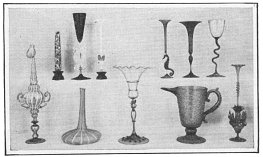
Up: Glassmaking

Glass & Glass-Making
7 of 28
|
|

| |
of the cup of the Holy Grail, preserved in the Genoa
Museum, and said to be the vessel in which Joseph of Arimathea received
the blood of Christ. Guglielmo Embriaco got it when
Caesarea was sacked in 1101, and brought it home to
Genoa. It was long thought to be made of an emerald; but when Napoleon
carried it to Paris in 1806, an expert decided that it was glass. The Holy
Grail is an hexagonal dish with feet and handles and slight ornaments
finished with a tool. It was broken in Paris. When mended, the pieces
were joined by a border of gold filigree.
French Glass
Glass is an ancient industry in France. In the
middle ages every province had its glass-houses. The art-loving
King René of Provence

A BYZANTINE "HEDWIG GLASS"
|
early welcomed Venetian artists in France. Henri II
brought Italians to Paris to improve glass-making, and
Henri IV established works at Rouen,
Paris, and elsewhere. Crystal glass, gilt and enameled
glass, and every other Venetian style were imitated.
France, however, was more occupied with magnificent
painted glass for her cathedral windows and, subsequently, with "plate-glass"
for mirrors and superb glass coaches like that of
Cinderella fame.
France produced fine work, although it was
overshadowed by the greater productions of Murano. Perhaps the most
interesting type is enameled glass made in the fifteenth century after the
Venetian style, with portrait heads, symbolic figures and mottoes, either
gallant or religious. This ware continued in vogue in France long after
the fashion had passed in Italy.
Enameled Glass of the Saracens
The enameled glass made by the Saracens during the
thirteenth, fourteenth and fifteenth centuries has only had appreciation as
a family, or class, for about thirty years;

VENETIAN GLASS OF THE SIXTEENTH CENTURY"
|
for it had been submerged under
the name "Venetian." The art came from Persia and was
developed in Damascus and Aleppo, where
Persian craftsmen lived in great numbers. The ware may be compared to rich
brocade of a dull gold gleaming with red, green, white and blue enamel,
the latter made of powdered
|
|